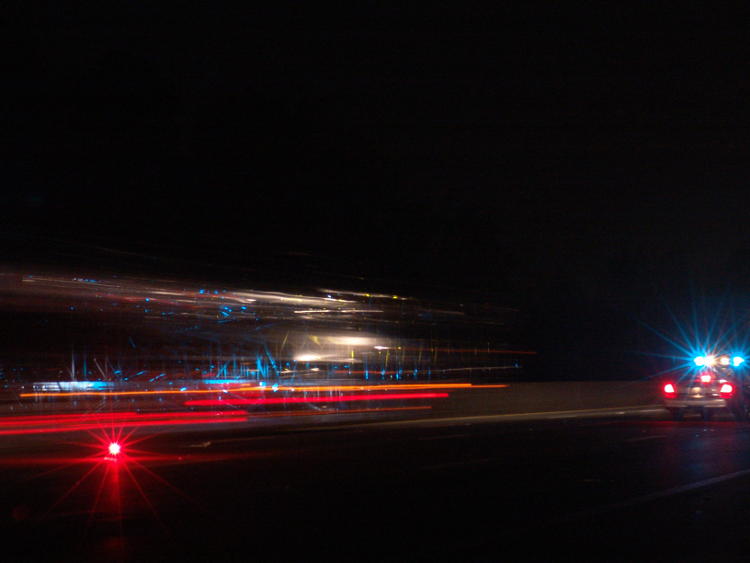
Some 14 years back while house-sitting for some friends who lived near the interstate, I went out for a walk one evening and noticed, off in the distance, a collection of flashing lights from emergency vehicles. At this point I was still largely shooting film, but my friend had left behind his Sony F-828, an upgrade from the F-717 that I’d used for a while in Florida, so I gathered that up with a tripod and hiked down towards the lights to see what was happening, with the thought that maybe I’d get something I’d long been after, which was a time-exposure with passing emergency vehicles in the frame.
Long story short: the accident looked minor, with not even an ambulance visible and just one disabled vehicle (looked like a spin-out, which people tend to forget is extremely easy to accomplish at highway speeds.) However, to allow access from both fire and wrecker vehicles, one lane of the interstate had been closed off with flares. The visibility of this extended for perhaps a thousand meters – I’d been that far away when I first spotted it, I believe.
I set the tripod up on the shoulder well away from the emergency vehicles themselves, but still within the region of lane closure and away from the road surface, so I was clearly not in anyone’s way, nor at risk myself. Well, much risk.
I was reminded how stupid people can be when, almost right alongside me, I heard a desperate squeal of brakes and locked tires and looked up to see a pickup truck fishtail to a halt within the closed lane. Either the idiot had approached the traffic ahead of him at way too high a speed, or had figured he’d duck into the ’empty’ lane to go around all those slowpokes. While he wasn’t too close to rear-ending a police cruiser, he also wasn’t far enough from it (again, highway speeds,) and somehow did not register the road flares that, really, couldn’t be missed unless you were unfathomably stupid. I quickly spun the camera around on the tripod and fired off a shot, so that’s what you see in the frame up there: the pickup is still rocking, with one of the road flares visible just beyond its rear tire, while a rig passes by in the correct lane. The blue ripples are reflections from the side of the trailer of the police cruiser not far out of the frame, strobes active (as they had been for the previous twenty minutes at least.) In fact, you can see a faint haze above the trailer itself, at the right end of the streak from the running lights, which may very well be the smoke from the idiot’s burned tires – I know I could both see it and smell it when I was there.
How close did he come? Well, here’s another shot that was a tad wider (shorter focal length) from the same position:

There’s the flare, and the police cruiser that was outside the previous frame. The other thing you’re seeing is a car carrier rig, illuminated by the blinking lights as it passed – cool effect. The flare looks closer or brighter than in the first photo, but I think that’s only because it wasn’t partially blocked by the idiot’s tire here – both exposures were only one second long.
A quick note about how hard it is to express field of view and focal length. Back in the day, as they say, it used to be relatively easy; with 35mm film cameras, each 50mm of focal length was about 1x magnification, so a 50mm lens was ‘normal,’ about what you’d see in person, while 100mm was 2x and so on. Everyone knew a 28mm lens produced a nice wide-angle shot. Then came digital, with much smaller sensors and commensurately shorter focal lengths, so this rule disappeared, and no guideline could be used among the different cameras. Eventually, the “35mm equivalent” started being used, and the Sony F-828 actually had such markings on the barrel of the zoom lens. Except, what’s saved in the EXIF info of the file isn’t the equivalent, it’s the actual focal length, so as I see that the top photo was shot at 37.7mm focal length and the middle one at 26.2mm, some translation is in order. It took a little research and a couple of quick calculations, but the equivalent is, top to bottom, roughly 100mm and 150mm – both short telephoto, meaning I was farther away than the photos make it appear, but not hugely.
I’ll close with one more, which only vaguely fulfilled my goals for that evening. As the wrecker pulled away with the accident vehicle (the original one,) I was prepared, up on the slope and dragging the shutter as it pulled into the lane. Interesting, but not quite what I was after – which I have yet to accomplish, but seriously, it’s not like I go out and try several times a year.





















































